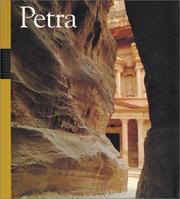Check nearby libraries
Buy this book

"If ever a dead city held romance it is Petra. . . . Hewn out of ruddy rock in the midst of a mountain wilderness, sumptuous in ornament and savage in environs, poised in wildness like a great carved opal glowing in a desert, this lost caravan city staggers the most experienced traveller." So wrote Rose Macaulay in her Pleasure of Ruins (1953), echoing the sentiments of generations of travelers before and since. Reached through a narrow, winding crevasse between looming cliffs in south Jordan, Petra served as the capital city of the Nabatean Arabs from the third century B.C.E to 106 C.E. (when it was occupied by the Roman emperor Trajan).
In this lavishly illustrated book, Maria Giulia Amadasi Guzzo and Eugenia Equini Schneider provide an accessible overview of the history and culture of the Nabateans, including their language, religion, politics, and economy, as well as a detailed guide to the city of Petra and its art and architecture. A major stop on the spice trade route, Petra attracted wealth and culture from across the Arabic and classical worlds and was abundantly furnished with more than 800 monuments. Perhaps the most well known of these is the Khazneh el-Faroun, or Treasury, a royal tomb more than 130 feet high with a magnificent Hellenistic facade carved from the salmon pink sandstone of the surrounding cliffs. But no less impressive were Petra's advanced achievements in hydraulic engineering, including elaborate water conservation systems and dams.
For anyone who has felt the lure and wonder of ancient cities and civilizations in exotic locations, Petra will be a delightful and invaluable resource.
Check nearby libraries
Buy this book

Showing 3 featured editions. View all 3 editions?
| Edition | Availability |
|---|---|
| 1 |
zzzz
Libraries near you:
WorldCat
|
| 2 |
zzzz
Libraries near you:
WorldCat
|
| 3 |
aaaa
Libraries near you:
WorldCat
|
Book Details
First Sentence
"The region constituting the Nabatean state at the time of Alexander the Great's successors and in the Roman era varied in size from one period to another."
The Physical Object
ID Numbers
Community Reviews (0)
Feedback?History
- Created April 30, 2008
- 6 revisions
Wikipedia citation
×CloseCopy and paste this code into your Wikipedia page. Need help?
| July 30, 2019 | Edited by MARC Bot | associate edition with work OL978220W |
| August 12, 2010 | Edited by IdentifierBot | added LibraryThing ID |
| April 24, 2010 | Edited by Open Library Bot | Fixed duplicate goodreads IDs. |
| April 16, 2010 | Edited by bgimpertBot | Added goodreads ID. |
| April 30, 2008 | Created by an anonymous user | Imported from amazon.com record |









